The Grant Shale member of the Winfield formation crops out in southern Gage County, Nebraska, and to the south in Kansas and Oklahoma. The Grant Shale in the Nebraska section is often a light gray-green to medium gray, silty shale that has a diverse fauna including bryozoans, brachiopods, mollusks, arthropods and echinoderms. Many of these fossils are large and have robust, ornamented shells that suggest they lived in fairly well oxygenated, shallow water near an ancient shore.
Brachiopods are bivalved animals that superficially resemble clams; their two valves are unequal in size and shape. Brachiopods usually open their shell in a plane that is perpendicular to their plane of symmetry whereas clams normally open their shells in a plane that is parallel to their plane of symmetry. The Grant Shale, compared to the Stull Shale or Kiewitz Shale, has a somewhat brachiopod fauna that contains relatively few species. Both articulate and inarticulate brachiopods are found in the Grant. Species of the atrypoid, productoid and strophomenoid groups are common in the Grant but species of all other brachiopod groups are rare to non-exist in the Grant Shale of Nebraska. The brachiopods in the Grant Shale are silicified, however, and some exquisitely preserved shells and structures can be observed by etching the specimens with acetic acid.
Brachiopods are sessile (non-moving) benthic (bottom dwelling) animals that fed on food particles such as microscopic plants and animals, larvae of animals, and decayed matter that were suspended in the water column in which they lived. Such animals are called suspension feeders. Brachiopods may have been attached to the substrate by a fleshy pedicle, anchored in the substrate by spines, or cemented to a hard object such as a rock or shell of another animal.
We have not attempted to give a formal classification of brachiopods here as that is beyond the scope of this page. Instead, we have followed the suggestions of Alwyn Williams (1956) who described brachiopods in terms of their calcareous shells and the shapes and structures common to the various groups.
Strophomenoid
Strophomenoid brachiopods can become rather large, some having shells of 75 mm (3 inches) in diameter. Their modified, usually triangular pedicle openings are often filled with small calcite plates. Strophomenoid brachiopods probably remained immobile in the mud into which the extended their long, steeple-like beaks. The valves are commonly flattened toward the anterior and they have a circular outline with very fine costae. These brachiopods often have very well developed muscle scars on their interiors. Derbyia, Schuchertella and Streptorhynchus appear to be the most common genera of strophomenoid brachiopods in Nebraska.
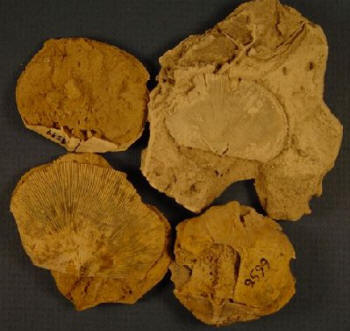
Derbyia crassa
Description: "Derbyia crassa" (Meek and Hayden) is one of the strophomenoid brachiopods that is found in the Grant Shale. These brachiopods may become large (up to 70 mm or more) as measured along the long, straight hinge line. These brachiopods usually have fairly flat shells and there is a triangular shaped but modified pedicle opening that is filled with tiny calcite plates that are called deltidal plates. These brachiopods appear to have remained immobile in the bottom muds.
Strophomenoid
Strophomenoid brachiopods can become rather large, some having shells of 75 mm (3 inches) in diameter. Their modified, usually triangular pedicle openings are often filled with small calcite plates. Strophomenoid brachiopods probably remained immobile in the mud into which the extended their long, steeple-like beaks. The valves are commonly flattened toward the anterior and they have a circular outline with very fine costae. These brachiopods often have very well developed muscle scars on their interiors. Derbyia, Schuchertella and Streptorhynchus appear to be the most common genera of strophomenoid brachiopods in Nebraska.
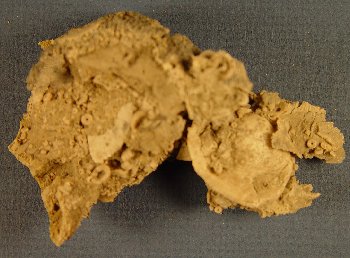
Composita subtilita
Description: Note on Composita: In their classic 1932 study "Brachiopoda of the Pennsylvanian System in Nebraska" Carl O. Dunbar and George E. Condra recorded at least four species of "Composita" from Nebraska. These are shown in the illustrations for your reference. Subsequent workers such as Norman Newell in Kansas and Myron Sturgeon and Richard Hoare in Ohio continued to recognize the species that were recognized or erected by Dunbar and Condra. Anne Lutz-Garihan studied a large number of "Composita" from the early Permian strata of Kansas and Oklahoma and showed that the genus was represented by an intergradational series of individuals that varied morphologically between two end members and none could be separated into groups that could be interpreted as separate species. Further, Lutz-Garihan showed that the end members did not differ in abundance and distribution in rock types, stratigraphic horizons or geographic areas and could not be explained as ecophenotypes, evolutionary populations or subspecies. Although "Composita" and its species have not been studied in the same detail as Lutz Garrihan's material, the genus shows a great variation in the stratigraphic units in which it is found in Nebraska, Iowa and Kansas. "Composita subtilita" (Hall) Many of the invertebrate fossils found in the Grant Shale have been preserved as a silicified fossil hash. The hash contains numerous shell fragments of brachiopods and bivalves and ossicles of echinoderms including crinoids and echinoids. Ocassionally a more or less complete shell will be found within the fossil hash, such as the specimen of this example of the brachiopod "Composita subtilita" (Hall). The fossils hash suggests that there were fairly strong and active currents that both pulverized and sorted the shell fragments from the finer particles and deposited them as irregular small bars on the substrate. The source of silica to preserve these fossils is not currently known. The shale and limestone deposits that overlie the fossiliferous units in the Grant Shale contain hollow geodes lined with quartz crystals as well as nodules of chert.
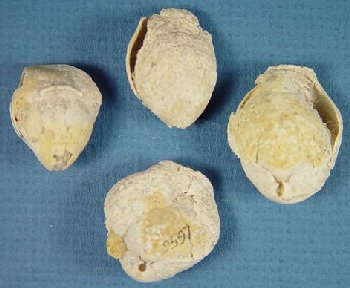
Composita subtilita
Description: Note on Composita: In their classic 1932 study "Brachiopoda of the Pennsylvanian System in Nebraska" Carl O. Dunbar and George E. Condra recorded at least four species of "Composita" from Nebraska. These are shown in the illustrations for your reference. Subsequent workers such as Norman Newell in Kansas and Myron Sturgeon and Richard Hoare in Ohio continued to recognize the species that were recognized or erected by Dunbar and Condra. Anne Lutz-Garihan studied a large number of "Composita" from the early Permian strata of Kansas and Oklahoma and showed that the genus was represented by an intergradational series of individuals that varied morphologically between two end members and none could be separated into groups that could be interpreted as separate species. Further, Lutz-Garihan showed that the end members did not differ in abundance and distribution in rock types, stratigraphic horizons or geographic areas and could not be explained as ecophenotypes, evolutionary populations or subspecies. Although "Composita" and its species have not been studied in the same detail as Lutz Garrihan's material, the genus shows a great variation in the stratigraphic units in which it is found in Nebraska, Iowa and Kansas. "Composita subtilita" (Hall) pedicle (upper) and brachial (lower) valves. Note the pedicle openings in the lower images. This is a part of the pedicle valve that is hidden when looking directly down on the pedicle valve.
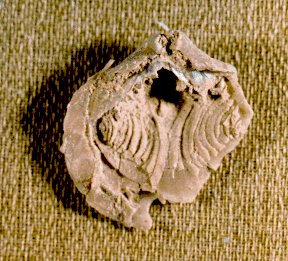
Composita subtilita
Description: Note on Composita: In their classic 1932 study "Brachiopoda of the Pennsylvanian System in Nebraska" Carl O. Dunbar and George E. Condra recorded at least four species of "Composita" from Nebraska. These are shown in the illustrations for your reference. Subsequent workers such as Norman Newell in Kansas and Myron Sturgeon and Richard Hoare in Ohio continued to recognize the species that were recognized or erected by Dunbar and Condra. Anne Lutz-Garihan studied a large number of "Composita" from the early Permian strata of Kansas and Oklahoma and showed that the genus was represented by an intergradational series of individuals that varied morphologically between two end members and none could be separated into groups that could be interpreted as separate species. Further, Lutz-Garihan showed that the end members did not differ in abundance and distribution in rock types, stratigraphic horizons or geographic areas and could not be explained as ecophenotypes, evolutionary populations or subspecies. Although "Composita" and its species have not been studied in the same detail as Lutz Garrihan's material, the genus shows a great variation in the stratigraphic units in which it is found in Nebraska, Iowa and Kansas. "Composita subtilita" (Hall) is a species of atrypoid brachiopod that ranges from the middle Pennsylvanian throughout the lower Permian. Like other atrypoid brachiopods, "C. subtilita" is characterized by having an inflated, tear-drop to nearly round- shaped shell with a very short hinge line. It has a pedicle opening on the pedicle valve and probably attached to the substrate with a fleshy pedicle. Atrypoid brachiopods have internal spring like structures called spiralia. One example shown here has the spiralia intact.
Productoid
Productoid brachiopods are characterized by having highly inflated, and spinose pedicle valves, long hinge lines, and large beaks. The spines may be several inches long. Some genera such as Antiquatonia have but a few robust spines whereas others such as Pulchratia or Linoproductus have numerous, fine spines. Some productoid brachiopods probably settled into a soft substrate by imbedding their spines in the soft substrate whereas some productoids appear to have cemented their spines to a hard object in the substrate. There are several distinct species of productoids in the Pennsylvanian of the mid-continent. Growth series have generally not been constructed for many of these brachiopods so it is not known which "species" are valid and which are growth stages of a described species.
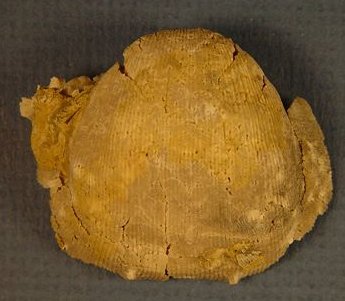
Linoproductus prattenianus
Description: "Linoproductus prattenianus" (Norwood and Pratten) is a very long-ranging species of articulate brachiopod. Articulate brachiopods open their valves along a hinge line with a tooth and socket structure. "L. prattenianus" first appeared in the Middle Pennsylvanian (Desmoinesian) and extended well into the Early Permian (Wolfcampian) strata of the North American midcontinent. This species is from the productoid group of brachiopods. The productoid of brachiopods are characterized by a highly inflated brachial valve, a long hinge line, a prominent beak and a series of spines along the hinge line and on the brachial valve. These spines were likely inserted into the soft substrate to stabilize the brchiopod. Some productoid brachiopods also appear to have attached their shells to solid objects with their spines. Once anchored to the substrate, the productoid brachiopod's station in life was fixed. Productoid brachiopods were most likely sessile, benthic suspension feeders that extracted food particles from the water column with arm-like structures called a lophophore. Productoid brachiopods also appear to have served as a solid substrate on parasitic or commensil organisms such as cranioid brachiopods, sponges, or bryozoans could establis residence.
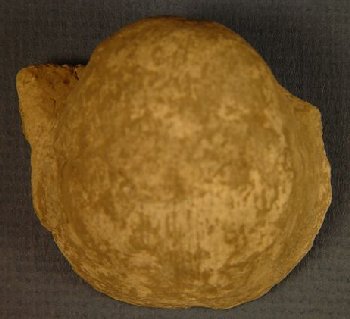
Antiquatonia portlockianus
Description: "Antiquatonia portlockianus" (Norwood and Pratten) is another productoid brachiopod that has been observed in the Grant Shale. It has a much thicker shell than Linoproductus and there is a reticulated (screen like) pattern on the posterior of the shell, near the beak on the pedicle valve. Since the brachiopod meets its environment at the opening of the shells and opposite the hinge line, the beak is actually at the posterior. This may be confusing to beginning students. "Antiquatonia portlockianus" (Norwood and Pratten), pedicle valve.
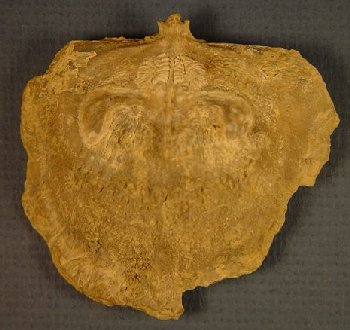
Antiquatonia portlockianus
Description: "Antiquatonia portlockianus" (Norwood and Pratten) is another productoid brachiopod that has been observed in the Grant Shale. It has a much thicker shell than Linoproductus and there is a reticulated (screen like) pattern on the posterior of the shell, near the beak on the pedicle valve. Since the brachiopod meets its environment at the opening of the shells and opposite the hinge line, the beak is actually at the posterior. This may be confusing to beginning students. "Antiquatonia portlockianus" (Norwood and Pratten), internal view of brachial valve. The protrusion at the posterior is called the cardinal process. It is where the dicuctor muscles that open the valves attach. The crook-like structures are the lophophore or food gathering mechanisms structure.
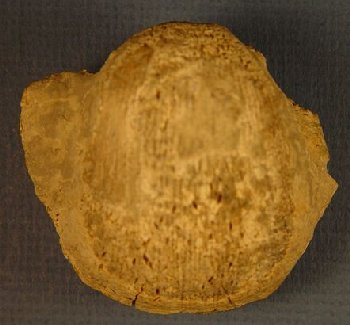
Antiquatonia portlockianus
Description: "Antiquatonia portlockianus" (Norwood and Pratten) is another productoid brachiopod that has been observed in the Grant Shale. It has a much thicker shell than Linoproductus and there is a reticulated (screen like) pattern on the posterior of the shell, near the beak on the pedicle valve. Since the brachiopod meets its environment at the opening of the shells and opposite the hinge line, the beak is actually at the posterior. This may be confusing to beginning students. "Antiquatonia portlockianus" (Norwood and Pratten), pedicle valve; the tiny chop-marks near the anterior (bottom) of the shell were made by commensal sponges. Such markings are common on many different invertebrate fossils.
Inarticulate
Inarticulate brachiopods are more common in black shale deposits than they are in other deposits such as limestone or gray shale. Thye may sometimes be found in great numbers on a single shale parting. Inarticulate brachiopods have phosphatic shells and open their shells with a musculature system rather than with teeth and sockets along a hinge line. Articulate brachiopods may attach with a pedicle and some are commensal, attaching to other brachiopods or organisms.
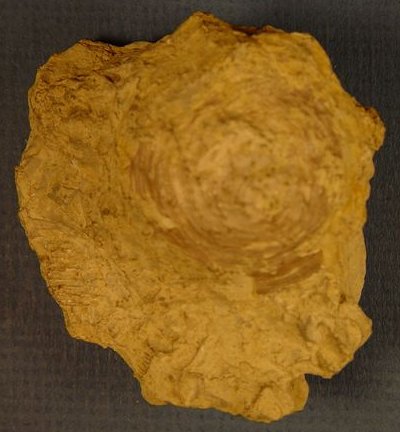
Orbiculoidea sp. cf. O. missouriensis
Description: "Orbiculoidea sp. cf. O. missouriensis" (Shumard) is a phosphatic-shelled, inarticulate brachiopod. Inarticulate brachiopods open their valves with muscular and ligamentous connections. "Orbiculoidea missouriensis" (Shumard) is a very long ranging species that is commonly found in black shale that indicates a dysaerobic (oxygen deficient) environment. This specimen is compared to "O. missouriensis" but not assigned to it. This specimen has a much larger shell than is commonly seen on "O. missouriensis" and it has been found in deposits that were more likely laid down in aerobic (well-oxygenated) water.